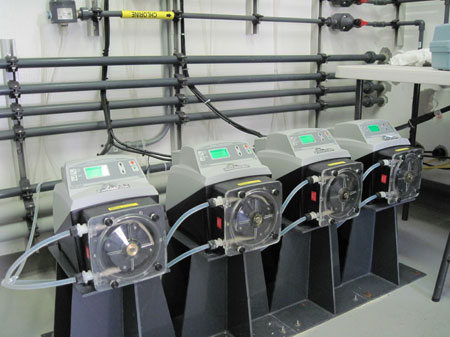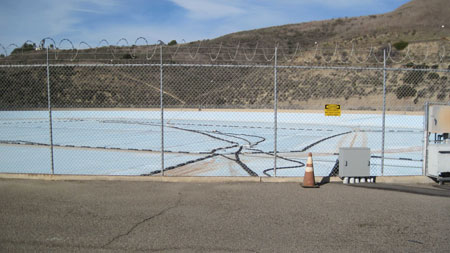South Coast Water District (SCWD) provides water to more than 40,000 residents and two million visitors a year in the coastal communities of southern Orange County, California. The water system includes chloraminated water purchased from the Metropolitan Water District of Southern California and stored in a 47 million gallon reservoir located in Dana Point, Calif. Although the water in the reservoir has already been treated, the chlorine residual will drop to undesirable levels if not maintained. SCWD is responsible for maintaining the residual trim system that monitors and adjusts the residual levels in the reservoir.
System
The residual trim system includes a sodium hypochlorite generation system and four injection/mixing systems. The sodium hypochlorite generation system uses a brine solution to generate a 0.8 percent chlorine solution, which is then stored onsite in a 1,500 gallon day tank. The injection/mixing system pulls water from the bottom of the reservoir and returns it to four different mixing systems inside the reservoir, providing continuous mixing of the water inside the reservoir. Four chlorine analyzers sample the water from four different locations in the reservoir and transfer the data to a PLC and SCADA system.
At the direction of the PLC, four chlorine metering pumps and four ammonia metering pumps inject directly into the outlet ports of the four mixing systems located inside the reservoir to ensure that the chlorine and ammonia are properly mixed and dispersed throughout the reservoir. The chlorine is injected at a rate of 17 gph and the 19.5 percent aqueous ammonia at a rate of 0.17 gph.

Photo of pumps installed at Dana Point reservoir sodium hypochlorite application.
Problem
Diaphragm metering pumps were originally specified for the chlorine injection. Steve Dishon, the chief plant operator, described the problems associated with the diaphragm pump installations, "The diaphragm pumps vapor locked all of the time. An operator would then have to go to the remote site and restart the pumps. Auto-degassing valves worked for a few months but then frequent and expensive repairs were required. Also, to prevent siphoning, back pressure valves had to be set well above 30 psi. Because of the high pressures and pulsation, pulsation dampeners were also required on the system and frequent maintenance to the pulsation dampeners was also necessary."
Dishon attributes the vapor locking problem to the fact that the injection lines going into the reservoir can be as long as 850 ft and the 0.8 percent chlorinated brine solution can reach temperatures of 122 deg F, especially in the summer.
In an attempt to eliminate the vapor locking as well as the high system pressure and hammering that required the pulsation dampeners, SCWD installed continuous flow gear pumps with VFD drives. Unfortunately, the gear pumps leaked and the internal gears and axles broke down and failed constantly, requiring frequent, expensive and time consuming gear replacement.

Reservoir located in Dana Point, California.
Solution
Next SCWD installed four peristaltic style metering pumps. Each of the peristaltic pumps was capable of injecting up to 33.3 gallons of sodium hypochlorite per hour at system pressures up to 125 psi. Since the peristaltic pumps provided smooth, near continuous injection at 17 gph, the pulsation dampeners were not required. The peristaltic pumps can easily pump out the vapor and cannot lose their prime. With no threat of siphoning, the system pressure was reduced to less than 10 psi. The PLC remotely started and stopped each of the four pumps.
Dishon reports that "Since these were installed, there has been zero downtime and the pumps have performed flawlessly with no maintenance and no signs of tubing wear. Using the built-in tube timer, we are able to view the current tube's run time."
After seven months of operation and more than 2,900 hours of zero required maintenance or downtime, the pump tube assemblies were replaced as part of scheduled maintenance. Dishon says that "the low cost of maintenance for the new peristaltic pumps was a tiny fraction of the cost of performing unscheduled repairs and service on the diaphragm and gear pumps. I am a firm believer in these pumps."
Conclusion
The South Coast Water District is continually striving to increase the efficiency of its water treatment systems while reducing the overall cost to the public, and the peristaltic pump proved more cost efficient than the diaphragm and gear pumps. The peristaltic pump installations have enabled SCWD to dramatically reduce the maintenance costs associated with the diaphragm and gear pumps and made the overall system more reliable. SCWD is pleased with the peristaltic pump's results and is in the process of upgrading other sites.
Pumps & Systems, March 2010


